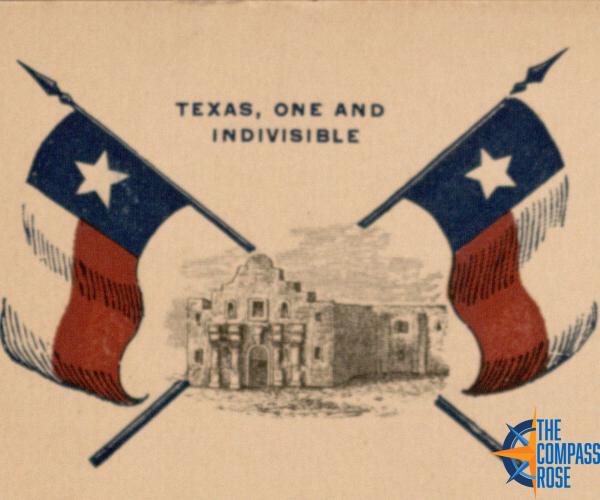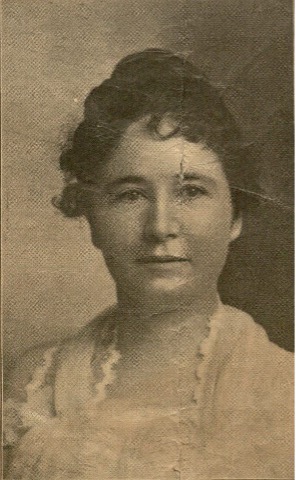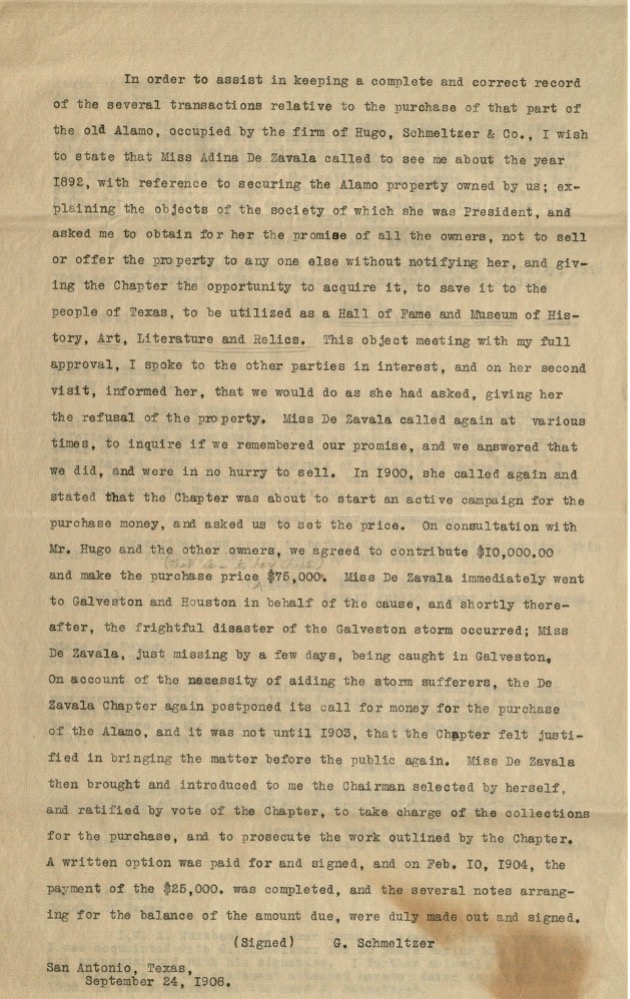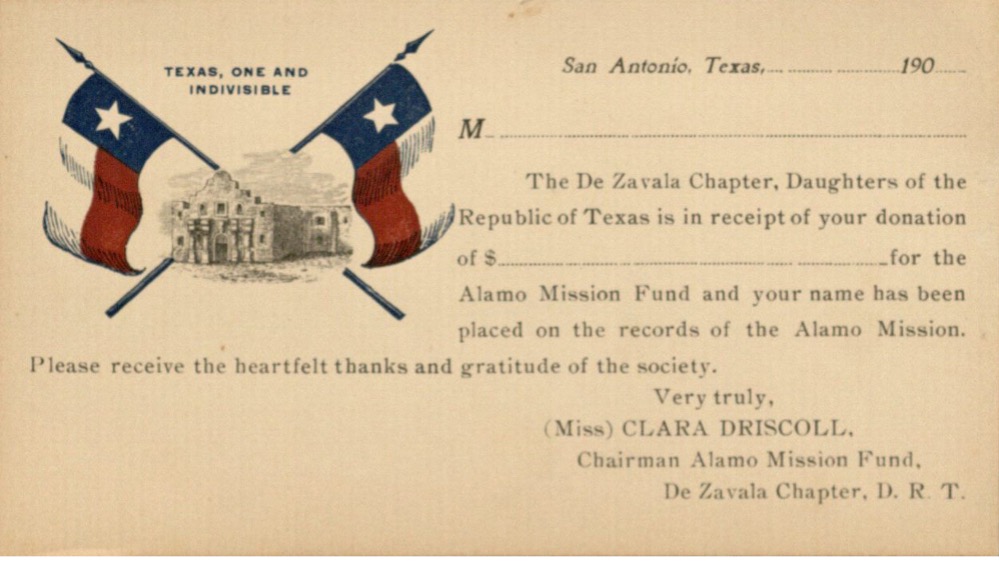
Adina De Zavala and the “Second Battle for the Alamo”
The purpose of The Compass Rose is to raise awareness of Special Collections' resources and to foster the use of these resources. The blog series also reports significant new programs, initiatives, and acquisitions of Special Collections.
May is Historic Preservation Month and to celebrate we are sharing the story of Adina De Zavala and her role in preserving the Long Barrack, which is the oldest building on the Alamo historic site ("Long Barrack").

Daughters of the Republic of Texas, De Zavala Chapter letterhead. From the Adina de Zavala Papers.
Adina De Zavala and Historic Preservation
Adina Emilia De Zavala was born on November 28, 1861 in Harris County, Texas. She was the eldest of six children born to Augustine and Julia De Zavala. She graduated from the Sam Houston Normal Institute (present-day Sam Houston State University) in 1881 and attended music school in Missouri. She taught briefly in Terrell and then in San Antonio but left teaching in 1907 to focus on her preservation work in the state.

Portrait of Adina de Zavala. From the Adina de Zavala Papers.
One of her greatest contributions to preservation in Texas was the preservation of the Long Barrack at the Alamo, which Robert Ables referred to as “the second battle for the Alamo” (Ables 412). Women have been involved with the historic preservation movement since the mid-nineteenth century. “Much of their work in the early years was done through all-female organizations; a long and sturdy amateur tradition stretched from the mid-nineteenth century through World War II” (Howe 31). In the 1880s De Zavala began working with other women in San Antonio interested in Texas history as a part of the Texas Historical Landmarks Association. They eventually became the De Zavala Chapter at San Antonio of the Daughters of the Republic of Texas (DRT) in 1893. (De Zavala & Donecker) After the chapter joined the DRT, the group worked on projects to preserve and mark historical sites, especially the missions around San Antonio. They also worked to name schools after notable people in Texas history. It was De Zavala’s interest in preservation and her role in this organization that led to “The Second Battle for the Alamo.”

Donation card for the Alamo Mission Fund. From the Adina de Zavala Papers.
“The Second Battle for the Alamo”
In 1841 the Republic of Texas passed an act granting custody of the the chapel of the Alamo and other mission churches to the Roman Catholic Church. In 1848 the church leased the property to the United States and the following year it was renovated. The state of Texas purchased the chapel of the Alamo from the Catholic Church in 1883. Although the chapel of the Alamo was owned by the state by 1883, the state wouldn’t take ownership of the convent until much later.

The Alamo, by Louis Glaser, Albertype on stiff paper, in Souvenir of San Antonio (New York: Adolph Wittemann, 1885). The University of Texas at Arlington Libraries Special Collections.
In 1877 Honore Grenet purchased the convent portion of the mission, also known as the Long Barrack, from the church. The walls of the convent were incorporated into Henri Grenet's general store and were covered with wooden frames and walkways. After Grenet’s death, Hugo and Schmeltzer Company bought the Alamo mission convent in 1886. Hugo and Schmeltzer removed some of the newly added embellishments, but kept the structure hiding the original building. De Zavala saw the historic importance of the building and in 1892 she secured a verbal agreement from the Hugo and Schmeltzer Company not to sell the property without giving their chapter the opportunity to buy it. Although De Zavala secured an agreement, she still faced a few obstacles when it came to the building’s preservation, even from within the DRT.

Court document signed by G. Schmeltzer recounting Adina de Zavala’s communication about not selling the property to anyone else without giving the chapter the opportunity to purchase it. From the Adina de Zavala Papers.
When De Zavala was notified that the owners of the convent building were considering a sale she enlisted the help of Clara Driscoll, a preservationist and daughter of a wealthy rancher. The DRT were not able to raise the funds and Driscol ended up paying most of the cost herself. Driscol purchased the Long Barrack from the Hugo and Schmelzer Company in 1904. In 1905 the Texas state legislature authorized state purchase of the Alamo from Driscoll and the State gave custody of the building to the DRT. Driscoll and De Zavala began to disagree on preservation efforts for the building. Driscoll and her DRT followers wanted to destroy the Hugo and Schmeltzer building claiming that it was erected after the battle in 1836. De Zavala led an opposition faction within the DRT that argued the convent needed preservation. The feud resulted in legal action on both sides to decide which group actually had control of the property. In February 1908, De Zavala barricaded herself inside the building for three days to protest its destruction. Deputies stationed on the property refused her food and water, but some news accounts claimed friends were able to send her food.
Her efforts were mostly successful, and the building was saved. In 1911, Governor Oscar Branch Colquitt ordered the Long Barrack be restored. However, in 1913 while Governor Colquitt was out of the state on business, Lt. Governor William Harding Mayes allowed the top floor of the structure to be demolished. Although De Zavala’s efforts were critical to saving this piece of Texas history, her efforts were sometimes overshadowed by the work of Driscoll partly due to the work of the DRT (Ables 412-413). In fact, when Driscoll died in 1945, her body was allowed to lie in state at the Alamo, but 10 years later De Zavala was denied that honor by the DRT. Her recognition has grown in recent years for her efforts to preserve this piece of Texas history.
In addition to her preservation efforts at the Alamo, De Zavala played an essential role in historic preservation around the state, including placing markers at historic sites, preserving the Spanish Governor’s Palace, serving on the Texas Historical Board, and becoming a charter member of the Texas State Historical Association.

Card for the De Zavala Chapter of the Texas Historical Landmarks Association. From the Adina de Zavala Papers.
“The Next Battle for the Alamo”
The fate of the Alamo is once again making headlines for what has been called “The Next Battle for the Alamo” (Tomlinson, Stanford, & Burrough). The Daughters of the Republic of Texas had been the caretaker of the Alamo site since they purchased it; however, in 2010 the Texas Attorney General received complaints that the DRT had been mismanaging the site. After a two-year investigation the Attorney General’s office found that they had not only mismanaged the Alamo site, but also cited mismanagement of state funds. A state law was passed in 2011 that transferred custodianship of the Alamo from the DRT to the Texas General Land Office. The property was officially transferred in 2015 (Huddleston). Discussions of redeveloping the Alamo complex have been ongoing for some years. A plan was announced in 2017 to repair the Alamo and fix up the plaza, but it also included building a larger museum space. One of the major collections to be housed in this new museum is a private collection that was donated by musician Phil Collins. Additionally, there was a plan to remove the Cenotaph (a monument dedicated to the Battle of the Alamo) and relocate it just outside the walls of the Alamo (Tomlinson, Stanford, & Burrough). The plan to move the Cenotaph was rejected but plans to revamp the Alamo and create a larger museum addition are still uncertain.
Bibliography:
-
Ables, L. Robert. "The Second Battle for the Alamo." The Southwestern Historical Quarterly 70, no. 3 (1967): 372-413.
-
Howe, Barbara J. "Women in Historic Preservation: The Legacy of Ann Pamela Cunningham." The Public Historian 12, no. 1 (1990): 31-61.
-
"Long Barrack." The Alamo. The Alamo. Accessed May 26, 2021.

Add new comment